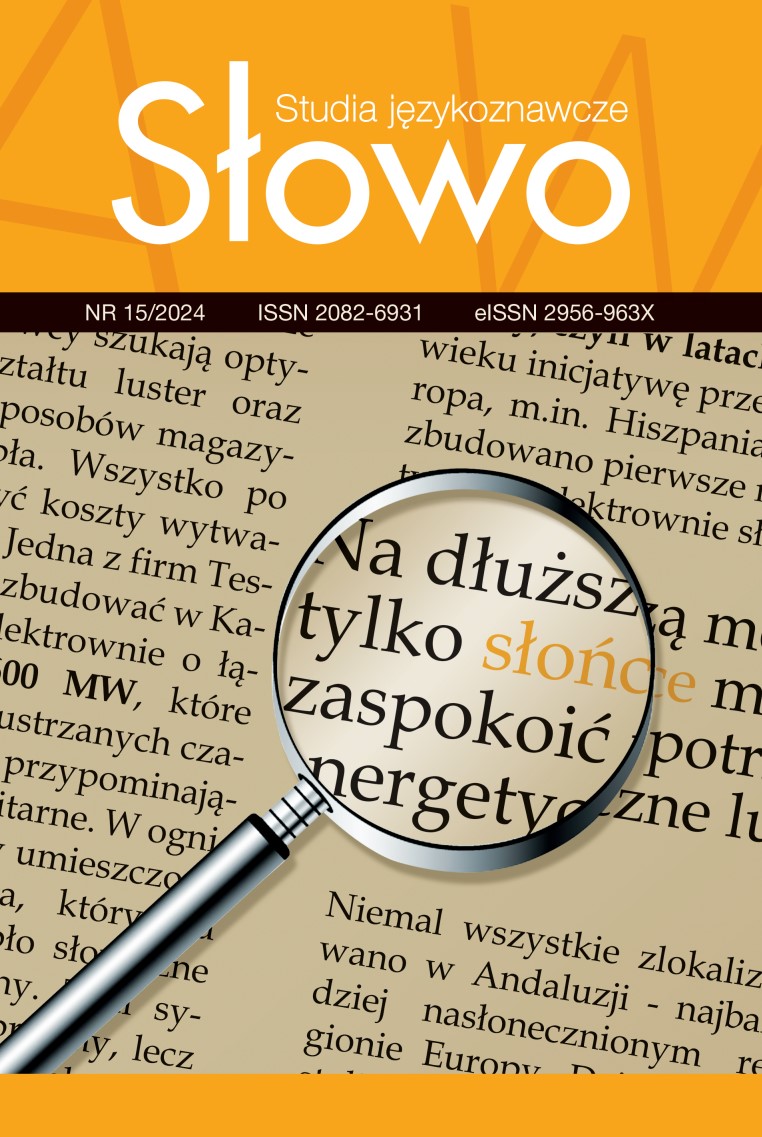Grupy spółgłoskowe w nagłosie toponimów w badaniu psycholingwistycznym
DOI:
https://doi.org/10.15584/slowo.2024.15.8Słowa kluczowe:
nazwy miejscowości, toponimy, grupy spółgłoskowe, fonotaktyka polskaAbstrakt
Tematem artykułu są zbitki początkowe w toponimach. Badano kilka czynników: istnienie, poprawność ukształtowania zbitki pod względem sonorności oraz odległość miejsca i sposobu artykulacji. Prawdziwe nazwy były częściej uznawane za potencjalnie istniejące. Nazwy sztuczne rozpoczynające się zbitką istniejącą i poprawną pod względem sonorności, były częściej identyfikowane jako potencjalnie istniejące. Nazwy sztuczne rozpoczynające się zbitką nieistniejącą i niepoprawną pod względem sonorności, były częściej identyfikowane jako potencjalnie nieistniejące. Przy nazwach rozpoczynających się zbitką nieistniejącą, ale poprawną pod względem sonorności lub istniejącą i niepoprawną pod względem sonorności, badani mieli większe problemy z udzieleniem odpowiedzi.
Downloads
Bibliografia
Bethin, C. (1992). Polish syllables. The role of prosody in phonology and morphology. Columbus: Slavica Publishers, Inc.
Cetnarowska, B., Żygis, M. (2007). Phonetic syllabification and morphological parsability: The case of prefixed words in Polish. W: J. Arabski (red.), Challenging tasks for Psycholinguistics in the New Century (s. 149–163). Katowice: Wydawnictwo Uniwersytetu Śląskiego.
Cyran, E., Gussmann, E. (1999). Consonantal clusters and governing relations. Polish initial consonant sequences. W: H. van der Hulst, N. Ritter (red.). The syllable. Views and facts (s. 219–247). Berlin: Walter de Gruyter.
Dryer, M.S., Haspelmath, M. (red.) (2013). The World Atlas of Language Structures Online. Leipzig: Max Planck Institute for Evolutionary Anthropology. http://wals.info
Dziubalska-Kołaczyk, K. (2009). NP extensions: B&B phonotactics. Poznań Studies in Contemporary Linguistics, 45(1), 55–71.
Dziubalska-Kołaczyk, K. (2014). Explaining phonotactics using NAD. Language Sciences, 46A, 6–17.
Goldsmith, J.A. (1990). Autosegmental and metrical phonology. Oxford: Blackwell.
Gussmann, E. (1991). Polish syllable structure: A hypothesis and its problems. W: M. Grochowski, D. Weiss (red.). Words are physicians for an ailing mind (s. 207–213). München: Sagner.
Jaskuła, K., Szpyra-Kozłowska, J. (2020). Wychódźc, Pcim i Rzgów. Grupy spółgłoskowe w nazwach miejscowości w świetle fonotaktyki polskiej. Język Polski, 100(3), 43–57.
Kita, M. (2017). Wybieram gramatykę! Dla cudzoziemców zaawansowanych na poziomie C i dla studentów kierunków filologicznych. Katowice: Wydawnictwo Uniwersytetu Śląskiego.
Orzechowska, P., Wiese, R. (2015). Preferences and variation in word-initial phonotactics: A multi-dimensional evaluation of German and Polish. Folia Linguistica, 49(2), 439– 486.
Rochoń, M. (2000). Optimality in complexity. The case of Polish consonant clusters. Berlin: Mouton de Gruyter.
Rubach, J., Booij, G. (1990). Edge of constituents effects in Polish. Natural Language and Linguistic Theory, 8, 427–463.
Śledziński, D. (2018). Wielowarstwowy model podziału wyrazów ortograficznych języka polskiego na sylaby. Polonica, XXXVIII, 1–24.
STATmediana. (2016). Końcówki nazw miast i miejscowości w Polsce. https://statmediana.com/badania-i-analizy/koncowki-nazw-miast-i-miejscowosci-w- polsce
Szpyra-Kozłowska, J. (2000). On some misconceptions concerning phonetic syllabifications in Polish. Folia Linguistica Anglica, 2, 159–173.
Wykaz urzędowych nazw miejscowości i ich części (Dz. U. z 4.08.2015 r., poz. 1636).
Pobrania
Opublikowane
Jak cytować
Numer
Dział
Licencja
Prawa autorskie (c) 2024 Słowo. Studia językoznawcze

Utwór dostępny jest na licencji Creative Commons Uznanie autorstwa – Użycie niekomercyjne 4.0 Międzynarodowe.


